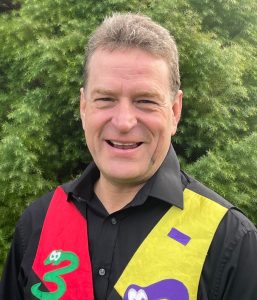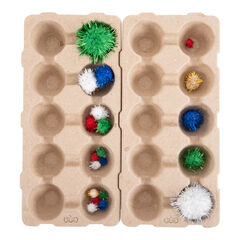Hi, my name is Dave Godfrey. I’m a teacher and an independent primary mathematics consultant from York, and I’m passionate about the use of concrete resources.
The focus of this blog and its accompanying video is on the use of egg box tens frames.
Egg Boxes
Egg boxes are brilliant for putting eggs in but they are also a magnificent mathematical resource!
They can come in all sorts of different shapes and sizes. I have examples at home of egg boxes that fit 6, 10, 12 and 15 eggs. I have used all of these as examples of arrays in the exploration of multiplication. This video and blog particularly explore 10s frames. For many years I’ve used cut up egg boxes. These trays are 6 x 5 arrays. I purchased 100 of these and then sawed them in the garage to create 300 10s frames. Cheap and cheerful, but also highly effective.
More recently, I’ve been using the new TTS Egg Boxes. These are a lot sturdier, and they fit well together. In my opinion, they are worth the investment. The great thing about egg boxes is that they can hold objects and be manipulated easily. This is a major advantage over paper tens frames!
Tens Frames – 5 and a bit image
Tens frames are now closely connected with mastery mathematics from Singapore and continue to be recommended by leading mathematicians.
We have for many years focused, understandably, on 1s, 10s and 100s etc., as we help children build their understanding of our Base 10 number system. Tens Frames enable children to see the importance and power of 5. My favourite arrangement of the number 7 in a tens frame is to put 5 in a row and 2 on the next line. I can then confidently state that, ‘7 is 5 and 2 more, 3 less than ten.’ This is mirrored in the 5-wise shapes, in tally charts, in the use of a rekenrek abacus (Slavonic abacus) and how we might represent 7 using our fingers.
Reasoning About Number – Exploring numbers to 10
Egg box tens frames can be used for a host of mathematical exploration, including counting, conservation of Number, subitizing, reasoning and arranging. Placing 7 cubes in a frame, children can explore their understanding of 7 – they can see it as 5 + 2, or 4 + 3, or 2 + 2 + 3 etc. They can move the 7 counters around and see that whatever arrangement they come up with there are always 3 less than 10. They might be encouraged to use mathematical vocabulary to describe the position of a cube. The red cube is in the second row, third from the right.
Papa Titioning – 74 logs
I have a lumberjack character called Papa Titioning, who arranged his stacks of logs into stacks of 10 and loose logs. I often use base 10 or number shapes to explore partitioning a 2-digit number into combinations of 10s and 1s, but egg boxes are the best image I’ve found. 74 is 7 tens and 4 ones. The same image can be seen as 6 tens and 14 ones, and 5 tens and 24 ones. This is made possible by the fact that a full egg box is both an image of 1 ten as well as an image of 10 ones.
Multiplication Magic
In the video I’ve demonstrated some my favourite ways I’ve used egg boxes in my teaching. I can remember teaching Year 3 a few years ago and we manipulated 4 egg boxes to represent 40 x 1, 20 x 2, 10 x 4 and 8 x 5. It was very powerful.
Modelling Calculation Strategies and Structures
Egg boxes are powerful tools for helping children develop conceptual understanding for calculation strategies, like round and adjust or manipulating the calculation. In the video, I model how 18 + 7 can be manipulated into 20 + 5 by the moving of two cubes from the 7 to join the 18.
When I’m encouraging children to use concrete resources to model a simple subtraction calculation, such as 9 – 4 = 5, the resource I would use depends on the story behind the problem. If the story was a partitioning one (e.g., 9 children, 4 are left-handed, how many are right-handed?) I’d use cubes and a part-whole model). If the story was a comparison story (e.g., 9 children, 4 adults, how many more children than adults?) then I’d use Number Rods (in a Number Track) or Number Frames. If the story is a reduction one (e.g., 9 children in my class, 4 went home poorly, how many are left?), then I’d be using cubes in an egg box tens frame.
Egg Boxes in Key Stage 2
Egg boxes are sometimes seen in early years settings and in Key Stage 1. They can however be powerful tools for exploration of mathematical concepts in Key Stage 2. One powerful example is their use with fractions. In the video I’ve modelled 1.4 + 0.8 = 2.2. In this instance a full egg box represents one whole.
Your use of egg boxes in school
Egg box 10s frames are powerful tools that fit perfectly with the CPA (Concrete, Pictorial and Abstract) approach within the teaching of mathematical mastery. It is the fact that egg boxes can hold objects and be manipulated so easily that makes them ideal 10s frames to use with your children. This video may act as a bit of an introduction, but I’m sure there are a host of ideas that I haven’t covered.
How effective are you finding the use of egg boxes in your school?
Please do share how you’re creatively using egg boxes and 10s frames with your children – I’d love to know!
With many thanks to Dave Godfrey for writing this blog for us.
Dave is an experienced primary teacher, mathematics consultant and trainer from York. He is also an author, songwriter and NCETM Professional Development Lead for the National Curriculum. Dave is passionate about equipping teachers to teach mathematics with deep understanding, clarity, enjoyment and creativity.
He is best known as the creator of the Number Fun. The Number Fun Portal gives access to over 350 videos that feature a unique combination of visualisation, animation, story, song and humour. (numberfunportal.com). Many of these videos, with their accompanying creative resources, include the representation of the concrete resources explored in these videos.
He travels widely across England to train and equip teachers, and to present his fun-filled and equipping Number Fun Days. Dave has many years’ experience of training teachers in the use of the CPA (Concrete, Pictorial and Abstract approach). He would be delighted to support you and your colleagues in developing their use within school.
- numberfun.com
- youtube/c/numberfun
- dave@numberfun.com
- @NumberFunDave









